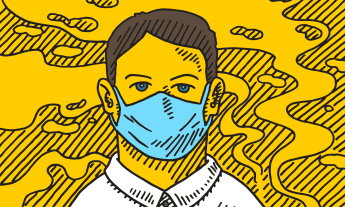
In the daily rush to save lives, hospitals produce a surprising amount of toxic waste. One environmental advocate’s quest to detox the healthcare sector.
When Gary Cohen runs down the list of harmful toxins that hospitals spew into the environment, he knows it can deliver a shock — especially to the people who run the hospitals. “I think the cognitive dissonance between their mission and their operations creates a very uncomfortable situation for them,” he says. Cohen (TEDxMadrid Talk: Healing hospitals) has spent the past two decades ratcheting up the discomfort through his advocacy group Health Care Without Harm. The industry, he says, has responded with sweeping improvements. So sweeping, in fact, that the MacArthur Foundation recently awarded Cohen a “genius” grant to keep pushing. Here’s how he’s trying to detoxify a $3 trillion industry.
First, do no finger-wagging. Cohen approaches negotiations as a fan of the healthcare system rather than an adversary. “Our hospitals are the cathedrals of our time,” he says. “They’re amazing achievements of technology.” The issue, he says, is that executives have focused so intently on individual patients that they’ve lost sight of their impact on the wider community. Meat pumped full of antibiotics that’s served in cafeterias can give rise to more resistant strains of bacteria. Cleaners and disinfectants washed down the drain can seep into our drinking water. Dioxins wafting out of medical incinerators can drive up cancer rates and birth defects. The list of hazards is long and insidious — and all too easy to ignore in the daily rush to serve patients. “It’s not like they knew that burning medical waste created dioxin and was linked to all these serious health problems and they said, ‘Let’s do it anyway,’” says Cohen. “They just didn’t know.”
Educate, educate, educate. Cohen’s technique for getting attention is simple: He presents hospital leaders with data. “Part of our job over the last 20 years has been to bring the latest environmental health science to this sector and to say, ‘Look, you are contributing to the very diseases that are showing up in people at your front doors,’” he says. So how can they fix it? For all the hazardous materials Cohen identifies, he can rattle off a shopping list of low-carbon, toxin-free, antibiotic-free alternatives. And if execs blanch at the price of, say, fair trade coffee (yes, that’s on the list), he reminds them: Don’t underestimate your power to negotiate a better deal. One dramatic swing in spending, he says, can trigger a price war among suppliers.
Big changes are possible. Take it from Wal-Mart. Cohen’s ultimate goal is to drive toxic products out of the healthcare sector. Fortunately, he doesn’t have to convince every hospital in the nation to change its spending habits at once. A single conglomerate can singlehandedly change prices. He likens the strategy to Wal-Mart’s hard-nosed negotiation tactics. “If Wal-Mart says it wants some greener product, because it’s so massive in its buying power, it can determine price,” he says. This isn’t theoretical — the retail giant was among the first to drive the price of LED lightbulbs below $10. And he’s seen healthcare companies like Kaiser Permanente, the largest healthcare organization in the US, pull off similar pricing wonders for gloves, thermometers, and waiting room furniture. “One of the big lessons of our work is that large hospital systems can drive the marketplace,” Cohen says.
Outflank the harmful suppliers. Remember mercury thermometers? No? That’s partly because Cohen’s organization lobbied hard in the early 2000s for an industry-wide switch to digital thermometers, a far safer alternative. He initially asked Becton, Dickinson, one of the biggest suppliers of both types of thermometers, to consider winding down the poisonous branch of its business. Its leaders politely declined; mercury thermometers were cheaper to produce and easier to sell, while digital versions were a niche product. So Cohen decided on a different way forward: Eliminate the market for mercury thermometers. He asked Kaiser Permanente to consider a switch to digital thermometers. Leaders there, for their part, were getting fed up with costly mercury spills that forced their cleanup crews to don hazmat suits. End result: They wrote a contract to purchase millions of digital thermometers. Prices plummeted as suppliers competed to produce newer, cheaper models. Before long, the digital thermometer business was booming. It’s now the dominant measuring device around the world, says Cohen, while mercury thermometers are on the way out.
Forget lawmakers. Just follow the money. “We haven’t done very much in the policy arena,” says Cohen, “because America doesn’t have a functional democracy, and because it’s a lot faster to move in the marketplace.” His goal is to band hospitals together into an association of shoppers who’ll demand environmental responsibility in everything they buy. He’s working with a membership organization called Practice Greenhealth that includes 1,400 hospitals, or about 20% of the hospital market, to help them think green — and then help them write their shopping lists. The hospitals themselves can then open up the discussion with their suppliers. At a recent conference in Boston, Cohen invited furniture manufacturers such as Steelcase, Knoll and Staples to sit down with the nation’s largest hospital chains. There, they discussed the healthcare industry’s demand for furniture that hasn’t been sprayed with toxic flame-retardant chemicals. “You’ve got all these hospitals saying, ‘You know what? If you produce this stuff, we’ll buy it, and we represent tens of millions of dollars in demand,'” Cohen says. In this way, good environmental choices get hardwired into the supply chain.
It’s not easy being green. Even well-intentioned purchasing decisions can have unintended consequences. Several years ago, when Kaiser proposed switching from latex gloves, which are linked to respiratory issues, to PVC plastic gloves, Cohen and his team asked them to hit the brakes. “You’re going to solve one problem and create another one,” he says, “because all of these gloves are going to wind up in incinerators somewhere and they’re going to get burned, and you’re going to create dioxin.” Two decades into the process and Cohen knows full well that the negotiations have only begun.
Illustration by Anna Parini for TED.












